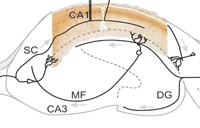York neuroscientist Georg Zoidl is looking into how fundamental communication processes function in the brain and what genes are critical to an adaptability to learn.
What he and a team of international researchers, including former colleagues from the Ruhr-University Bochum and the University of Miami’s Miller School of Medicine, found is the channel protein Pannexin1 plays a critical role in maintaining synaptic strength and plasticity in certain neurons  of the brain. What this means that is the presence of Pannexin1 supports the neurons’ ability to learn and signal or remember and communicate.
of the brain. What this means that is the presence of Pannexin1 supports the neurons’ ability to learn and signal or remember and communicate.
Georg Zoidl
“Without synaptic plasticity in the nervous system, people would not be able to learn or to forget anything,” says Zoidl, senior principal investigator for the study and a Canada Research Chair in Molecular and Cellular Neuroscience. Synaptic plasticity is a neuron’s ability to adapt to new experiences, a fundamental process that becomes more difficult without the Pannexin1 gene.
The results of the study are published in an article – “Pannexin1 Stabilizes Synaptic Plasticity and Is Needed for Learning” – in the December issue of the journal PLOS ONE.
“The nervous system is like a house built from brick stones. Pannexin1 is like a single brick in the foundation of a wall in that house,” says Zoidl of the Faculty of Health. “What happens to the rest of the house when one of the bricks in the foundation doesn’t fit?”
The team used a mice model with and without Pannexin1 channels to investigate learning and behaviour. In an impressive experiment the two different mice were then let into an enclosure where they had been trained before to identify a cookie in a specific location.
The mouse with a lack of Pannexin1 ran around the space as normal mice do when in a completely new environment. The mouse with Pannnexin1 ran directly to the area where it  remembered cookies had previously been buried. This mouse remembered past experiences better than the mouse without the Panx1 gene.
remembered cookies had previously been buried. This mouse remembered past experiences better than the mouse without the Panx1 gene.
Overview of the mouse hippocampus highlighting the major structures, signalling pathways and position of electrodes (Stim, Rec) used to evoke long-term potentiation (LTP). LTP is a candidate mechanism for memory
The mice without Pannexin1 channels were found to have major differences in their molecular and physiological functions, affecting their learning and memory formation. The absence of the gene also led to distinct behavioral alterations, including enhanced anxiety, and impaired recognition and learning tasks.
Zoidl and the team observed that a deficiency of Pannexin1 causes chronic depletion of the signalling molecules ATP and adenosine, which are crucial for energy transmission and signalling in the brain. If the Pannexin1 channel can no longer release ATP and adenosine naturally, signalling (necessary for learning) and energy functions (used for everything in the body, including things like moving muscles) are severely diminished or disturbed. However, Zoidl and the team found that a lack of Pannexin1 can be treated in mice by balancing the levels of the ATP and adenosine molecules in the body.
Pannexin1 is implicated in a wide spectrum of brain disorders, including but not limited to epilepsy, ischemia, inflammation or cancer. Most recently, Pannexin1 has been associated with autism disorder, but the precise nature of Pannexin1 dysfunction in the brain still hasn’t been determined. This is one of the studies that is helping to close the gap.


